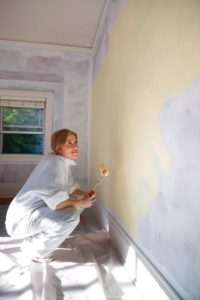Great time to paint inside!

DIY painting tips
As we get into spring and our minds run to freshening things up a bit around our places, one easy thing we can do to put a new face on our home is some painting inside. This is a great time to do it, before the weather beckons us out to work on our landscaping and exterior maintenance. In addition, with the right process, tools, and patience you can do an excellent job with this yourself, without paying a painting crew to come in.
Here are some tips that might help you get started in the process.
Tools:
Plastic or fabric drop cloths – bigger is better, but not so big they make it difficult to reposition them. Something about 8 x 12 is reasonably cheap and easy to move around.
Brushes – buy the best brush you can justify and keep it nice. It will last for a long time.
Blue tape – for taping the drop cloth down if you need to, and taping off windows and trim. At least one inch wide. Don’t buy the thin stuff – it will just tear on you.
Paint tray and liners – If you are going to be doing a lot of painting, you should buy two trays or a pack of paint tray liners. Two trays allows you to wash one and use the other one, or liners that are disposable let you change colors when you need to.
Rollers and covers – buy a good roller. The cheaper ones tend to become loose and flimsy meaning you lose control over where your paint goes. Do a little research on the different “naps” of rollers. Here is an article that talks about that.
Stepladder – to make sure you aren’t stretching with a paint brush or roller full of paint!
Work light or flashlight – to shine along the wall so you make sure you don’t miss any spots. If you position it so you shine it along, rather than straight at, the wall, you will see the wet areas where you painted better.
Rags and some water – we all make mistakes.
Process:
Find your paint color – look on some websites for ideas like Houzz or Pinterest. You might get inspired to do something a little outside your initial intentions. Pick at least 3.
Sheen – Interior paints come in different mattes or sheens. Find the one you like and test it to see the different appearances. Typically, folks go with flatter sheens on the walls – matte or semi-gloss; and eggshell of semi-gloss on trim to make it pop a little.
Test – pick up a small container, or sample, of the colors you are interested in. Go ahead and paint a small area on your wall with it and let it dry then decide. Test with other colors too, just to make sure you like what you see.
Plan – Where will you start painting? Think through how you will be moving furniture around as you go, and what you can live without for a day or two while you paint, if necessary.
Protection – move furniture that might obstruct your work. Place drop cloths over furniture you will be working near and on the ground where you will be starting to paint. You can use the blue tape to anchor the drop cloth if you need to.
Light – set up your lighting or have a flashlight handy to use as you go.
Rags – get rags and water handy but in a place you won’t knock it over.
Paint – doesn’t matter if you start at the top or bottom, but you will probably have a better result if you start using your brush and “cutting in” where you need to. This will be at the ceiling, usually, and along any trim. If you are going to paint the trim, do it last and you don’t need to tape it. Same goes for the ceiling. If you practice in one place a little, you might quickly be able to learn how to “cut in” along the ceiling. Have your rag handy at first, as you will make mistakes with this.
Second coat – it is always advised that you do two coats. The results are always better, and usually closer to what you hoped for.
Clean up – if you are going to use your brush or roller again later with the same color, you can just put them inside an old plastic bag and wrap them where the paint is. They will be ready for you to start. If not, or if they are really loaded with paint, then go ahead and wash them. Please wash them inside, to keep the chemicals away from runoff that may find its way to salmon streams or wetlands.
Here are a few links to articles that you might find useful:
Expert tips for choosing the right paint color – The Washington Post
9 Little-Known Tips for DIY Interior Painting (nationwide.com)
Interior Painting How-To’s | Sherwin-Williams (sherwin-williams.com)

